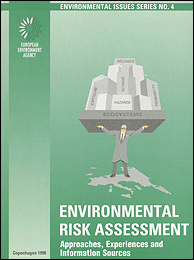All official European Union website addresses are in the europa.eu domain.
See all EU institutions and bodiesAn official website of the European Union | How do you know?
Environmental information systems
EN

- БългарскиBG
- češtinaCS
- HrvatskiHR
- danskDA
- NederlandsNL
- ελληνικάEL
- EnglishEN
- eestiET
- SuomiFI
- FrançaisFR
- DeutschDE
- magyarHU
- ÍslenskaIS
- italianoIT
- LatviešuLV
- lietuviųLT
- MaltiMT
- NorskNO
- polskiPL
- PortuguêsPT
- RomânăRO
- slovenčinaSK
- SlovenščinaSL
- EspañolES
- SvenskaSV
- TürkçeTR
Environmental issue report 4/-1
Environmental Risk Assessment - Approaches, Experiences and Information Sources
Report (PDF)

Environmental Risk Assessment - Approaches, Experiences and Information Sources
Environmental issue report 4/-1
24 Mar 1998
EN PDF: GH-07-97-183-EN-C - ISBN: 92-9167-080-4
